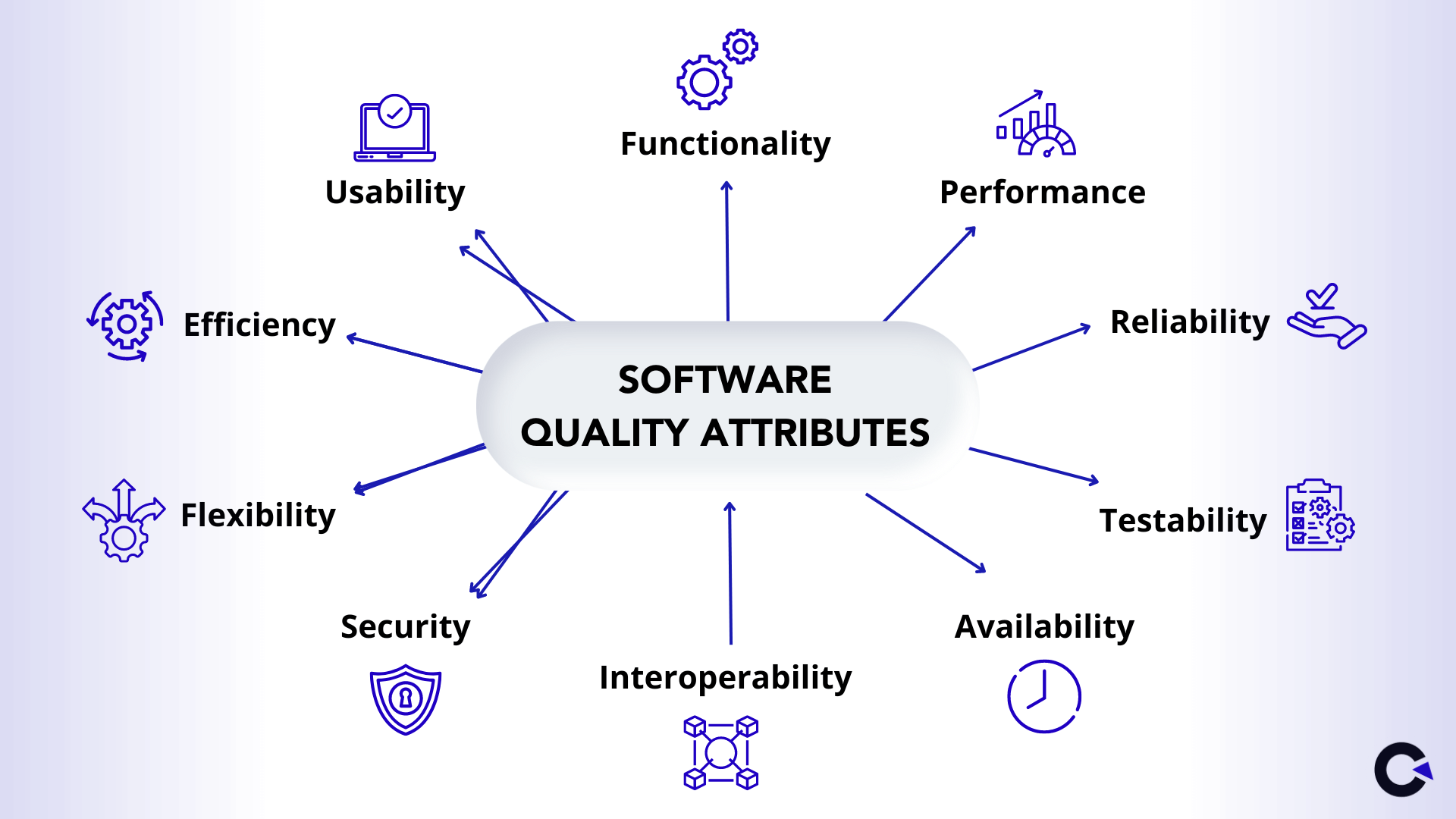
by admin | Aug 14, 2019 | Software Testing, Fixed, Blog |
Software Quality Attributes are features that facilitate the measurement of a software product’s performance by Software Testing professionals. They play a vital role in helping software architects guarantee that a software application will perform as expected based on the specifications provided by the client. Though there are numerous software quality attributes, we will be focusing on the most important ones that we have mentioned below.

List of Software Quality Attributes
Some other essential software quality attributes that we have not covered in this blog are correctness, learnability, robustness, maintainability, readability, extensibility, and portability.
Functionality
The first from the list of software quality attributes we will be focusing on is functionality. This attribute determines the conformity of a software-driven system with the defined requirements and specifications.
Most Software Testing professionals view this attribute as the most important one as an application fails on the most basic level if it doesn’t function as expected. That is why we always advocate performing tests that assess the desired functionality of a system during the early stages of software testing.
Performance is on our list of the most important software quality attributes as it is a very important trait for every software to have in this fast-paced world. It can be understood as the ability of a software-driven system to conform to timing requirements.
From a testing point of view, it implies that QA testers must check whether the system responds to various events within defined time limits. These events may occur in the form of clock events, process interruptions, messages, requests from different users, and so on.
Reliability
Now that we have seen the functionality & performance software quality attributes, let’s shift our focus to reliability. Reliability is to check if the application or the testing product with different combinations to see if it withstands its nature and produces the expected results. By different combinations, we mean testing it in different browsers, operating systems, environments, and so on.
Testability
Being a leading software testing company, this is a very important software quality attribute to us. It indicates how well the application allows software testers to perform tests in line with the predefined criteria. In addition to that, this software quality attribute also assesses the ease with which QA engineers can develop test criteria for a said system and its various components.
QA professionals can assess the testability of a system by using various techniques such as encapsulation, interfaces, patterns, low coupling, and more.
Availability
As the name suggests, this software quality attribute indicates whether an application will execute the tasks when they are assigned. It can be defined as a ratio of the system’s available time to the required time it is expected to perform.
Top-notch availability indicates that a software-driven system will recover from operational failures or scheduled maintenance periods without exceeding a specific time value. Availability also includes certain concepts that relate to software security, performance, integrity, reliability, dependability, and confidentiality.
Interoperability
Software-driven systems could be required to communicate and act in tandem with different systems to perform certain tasks. Interoperability is the ability of the system to interact with other systems to exchange the required information via certain interfaces. So, Software Quality Assurance engineers must examine the interoperability of a system in terms of both syntactic and semantic interoperability.
Security
We have added security to our list of the most important software quality attributes as it has lately been the need of the hour. The number of cyber-attacks has been on the rise and users have started prioritizing a product’s safety. So the security attribute measures the ability of a system to protect and block malicious or unauthorized actions that could negatively impact the user or destroy the system.
Security also includes authorization and authentication techniques, protection against network attacks, data encryption, and other risks. It is imperative for Software Testing Companies and professionals to regularly conduct updated security checks on systems.
Flexibility
If keeping up with the security threats is a key aspect, so is the system’s ability to keep up with the upcoming trends and requirements. And for that, the system should be flexible enough or should be able to modify accordingly.
For example, let’s say you’re working on a web application that was developed when Windows 8 was launched. As the OS gets upgraded, the application should be flexible enough to support future versions such as Windows 10 & 11.
Efficiency
Though mentioned at the bottom, it is still one of the most important software quality attributes. Why? Because an inefficient application might work well only when it consumes excessive resources that slow down other applications or the system on the whole. In addition to checking how long it takes to complete a process, it is also important to check the level of system resource usage.
For example, if the system uses the entire CPU power and memory for a single application. It can be considered to be inefficient as it pulls down the performance of the entire system from the user’s perspective.
Usability
Though all software-driven systems are designed with ease of use in mind, not all achieve this goal. And the software quality attribute of usability denotes the ease with which users are able to execute tasks on the system. It also indicates the level of user support provided by the system.
In addition to general usability, Software Quality Assurance engineers must also test if the software is accessible to people with different types of abilities. Usability plays a critical role in a product’s success and the most well-known principle to achieve it is KISS (Keep It Simple Stupid).
In Conclusion
As one of the top QA companies, we firmly advocate using these software quality attributes to access the performance of a software product. We stand by the fact that these attributes lead to the creation of balanced and highly functional software applications and products. We have published a lot of high-quality blogs on software testing and encourage you to explore our collection.

by admin | Aug 11, 2019 | Software Testing, Fixed, Blog |
Release notes are technical documents that go out with software products. An effective set of release notes is one that can engage users and inform customers with regard to the efforts made by the product development team (or testing team) to fix bugs and issues found with previous iterations. Release notes may be displayed on a public domain when a software product is still in the development or test state. For products that have already been in use by clients, release notes accompany the release of an update.
Who Is The Audience?
Each section of an audience may prefer a different tone and may have diverse tastes in the type of information they would want in the release notes. This factor should heavily influence the content of a batch of release notes.

Where Are They Being Published? The location of publishing release notes – such as inside a mobile app, in the public domain, via email, a certain blog, and others, influences the flavor of the information contained therein. Certain companies may elect to create and populate a dedicated release notes page on a website in the wider interests of their digital audiences.
When Would The Release Notes Be Published? The timing of publication is important for release notes. Depending on certain factors, Product development companies can publish these notes on a weekly, monthly, or quarterly routine. Testing professionals must ensure they plan the release at the most opportune time. Writing clear, specific release notes helps a company to elevate the level of communication with clients and customers regarding the progress registered on a product. These notes prove highly effective and useful to attract potential customers as well.
What Must Be Included? The guiding factor for release notes should be the understanding of what a company aims to communicate through them. A close watch on changes effected inside a software application or digital product should precede the compilation of release notes before publication. The best release notes are those that are grouped logically: by subject and points of improvement. Also, they should describe software fixes, improvements, and new features to arrest the attention of readers and customers. Further, the best release notes contain web-links and high-level summaries that guide readers to different headings.
Who will script them? Several personnel may write release notes for a software application. Organizations typically deploy developers, QA testers, technical writers, and product managers to script the release notes. The best QA companies understand the criticality of these with regard to customer experience and therefore, multiple release notes would be designed and published to cater to different audiences. In modern times, commercially available project management tools incorporate elements of release notes automation. This helps reduce manual interventions and result in meticulously designed, audience-specific, personalized release notes.
Categories, Titles, Dates of Release Experienced companies would include a title and a date for each batch of release notes. Titles and dates educate readers and customers on the context and immediacy, therefore helping them to engage with the content of the earlier versions of such notes. Meanwhile, categories would describe various actions such as bug fixes, new features, and improvements. Information can also be organized by category thereby enabling readers understand and assimilate the information systematically.
Tone and Formatting A software developer or QA company can introduce the tone and voice of the brand through the release notes. Expert testers recommend a uniform tone through multiple batches of release notes as part of efforts to reinforce a brand image. In terms of formatting, release notes would include headings, bullet points, and number lists, to make reading and understanding faster and easier.
In Conclusion
Release notes are an important addendum to the software development lifecycle. These notes convey a commercial message – the success of the customer is important to the sponsor organization. Release notes must remain consistent and repeatable, and when done right, they help to expand and strengthen the relationship of an organization with its client base. We are experts in the realm of software testing and our experts are proficient in the making of release notes, in addition to a huge gamut of services. Don’t take our word for it – connect with us and experience it.

by admin | Jul 11, 2019 | Software Testing, Fixed, Blog |
Constant demand for high quality software applications and packages drives the multi-million Dollar software Quality Assurance industry. Veteran testers maintain the opinion that software testing is never complete and the scope for further testing remains relentless. However, the commercial compulsions that operate in the industry demand low prices for QA Services and adherence to sharp delivery timelines provided by clients. This matrix compels Software Testing professionals to deploy risk-based analyses to locate the areas of software development that must be targeted with exhaustive testing procedures. Therefore, we may say the quality of testing emerges as a prime objective for the modern Software Testing Company.
Quality is King
Testing organizations that offer QA Services must prize top quality of work when the choice is to provide the best services to clients. This realization has forced a calibrated overhaul of assessing the impact of Software Testing services. Such overhaul tends to commence with a change in mind set wherein a Software Testing Company encourages computer code testers to pool their creative resources and brainpower with a view to elevate the quality of rendered services. In line with this, Software Testing engineers must share their technical knowledge and review testing scenarios and test cases. The outcomes can include superb quality of testing, often resulting in clear instances of client delight.

Numbers can deceive
Professionals who undertake Software Testing activities must acknowledge that pure numbers, when used to assess the professional performance of a tester, can lead to eventual disruptions in service delivery. A test professional, for instance, can review a large number of bugs and initiate remedies to eliminate such glitches. However, this approach can earn his or her employer – the Software Testing Company – the proverbial bad name when the functionality of the tested software application fails to impress, owing to low quality of bug resolution. The only true remedy that can negate such a situation is to deliver a product that excels in terms of quality. This lodestone, centered on quality, should emerge as a defining feature of the metrics that define Software Testing systems and practices.
An Eye on Profit
Every Software Testing Company must remain commercially viable before it establishes a presence in the software testing market. In this context, it is obvious that the state quality of services would equal a growing profit margin. Therefore, management teams must impress this fact on Quality Assurance professionals, and such learning must be implemented in the work day practices of each individual tester. Essentially, high quality outcomes must drive Software Testing activities, which include collecting requirements, defining the scope of software testing, work allocation, co-ordination between different work teams, and more.
Customer Satisfaction
p>Every QA Company worth its proverbial salt must strive to drive high levels of customer satisfaction. In line with this, Quality Assurance professionals must build and create clear priorities when planning the scope of testing activities. A different strategy emerges when QA Services engineers begin with the question – what does the customer want? This query, as a starting point, can serve to inform and enrich the quality of Software Testing services in the modern context. The query serves as the archetypal lodestone that guides the actions of a Software Testing Company when decisions must be taken to take testing projects into maturity stages.

Target: Root Causes
Quality Assurance practices must center on seeking the root causes of a software glitch. This approach allows Software Testing professionals to effect a permanent remediation of a glitch, thereby elevating the level of quality services rendered to clients. Such an approach must be promoted highly when a Software Testing Company compiles its list of best practices. Root causes must also feature when Quality Assurance professionals write test cases prior to embarking on software testing activities. Each test case must be constructed to test the software application from multiple points of view, thereby covering all the requirements listed in the work brief provided by the client. In time, such practices will eradicate the worst of software glitches and result in client delight.
Be the Best Tester!
High levels of motivation and technical skills can combine to work wonders when Quality Assurance professionals apply themselves to their duties. This implies a personal stance predisposed to quick and constant learning, a passion for testing software applications, decent communication skills, understanding the priorities of the testing landscape, an ability to think through technical problems, and much more. These attributes can empower a Quality Assurance professional to perform at peak power, and drive outstanding results in projects undertaken by a Software Testing Company.
In Conclusion
The rationale and logic mentioned above drive a solid case for choosing quality over quantity in the domain of modern Quality Assurance services. In line with this, every Software Testing Company must make it mandatory for testers to undergo appropriate training and sensitization modules that spotlight the core necessity of quality in services rendered to clients. Pursuant to such actions, the modern Software Testing industry can undergo tectonic shifts that may raise standards across the industry. When you seek both quality and quantity, connect with us and experience the difference.

by admin | Jul 7, 2019 | Software Testing, Fixed, Blog |
Test Execution holds immense significance in the software development process, especially in the Software Testing Life Cycle (STLC). The Test Execution stage is crucial since it ensures thorough testing of the software product. In this stage, testers detect errors and bugs in software besides performing the testing of the test cases.
In Agile environments focused on continuous delivery of software, testers are generally under immense pressure to speed up test execution. This is so because accelerated text execution ensures the faster release of an exhaustively tested quality software product. If you are a tester expecting and wanting to accelerate your test execution, you would be helped by focusing on the points enumerated below:

Organize Your Tests
For quick execution of tests, it is imperative that a software testing company ensures that its testers organize testing on a daily basis, so that the process is properly streamlined. To organize tests, it is necessary to automate features at the unit level, aiming for lean and reusable test cases. Tests can be easily run whenever required with the practice of efficient text management techniques, maintain accurate data, and prepare clean automation reports.
Identify the Best Cases for Automation
Testers should be able to use automation testing to their advantage if they expect to achieve an exponential increase in the testing speed. Automation can lead to a significant reduction in the testing time when the right test cases are automated. Hence, a clear understanding of the respective benefits of manual and automated testing is necessary, as is the identification of the best cases for automation. For instance, regression testing should be automated, while exploratory testing for new test cases should be performed manually.
Leverage the Parallel Testing Technique
The Parallel Testing technique is a timesaving testing method that allows the simultaneous execution of a number of tests. Software testing companies recognize the importance of leveraging parallel testing for faster automation, particularly because it enables testers to run the same tests across different browsers, operating systems, and devices. It is possible to reduce the test execution time drastically by learning the use of parallel testing tools such as Selenium grid and Test Load Balancer (TLB).

Use the Right Tools
Testers should be fully acquainted with the use of different test execution tools — or ‘test running tools’ — if they want to accelerate the test execution process. The selection of the most suitable test execution tools for running automation testing can effectively speed up the test execution process. You can test more code at a notably faster pace, and with greater test accuracy, if you can adeptly use test automation tools like Selenium, TestComplete, eggPlant, Watir, Robotium, and TestLeft, among several others.
Execute Tests in Multiple Categories
The breaking up of tests into smaller groups or multiple categories can result in quick feedback from the tests. The division of software into logically separated sections can enable the fast testing of the independent sections before they are tested together. The tests can be divided into different categories based on the functionality or nature of the tests. Towards that end, Smoke Testing can include tests that corroborate the working of critical functionalities, whereas Regression Testing can include tests that cover all other workflows.
Eliminate Flaky Tests
Testers who are experts at using various test execution tools know that excellent automation testing tools like Selenium can sometimes lead to flakiness. Flaky tests are those that fail randomly and pass on re-run without any change in the code. These tests purge the advantages of the bug detector in automation tests and eliminate confidence in the test-suite. Therefore, to reduce flaky tests and ensure a speedy test execution, it is necessary to identify and isolate flaky tests, analyse the cause of and fix the flakiness.

Keep Lines of Communication Open
Efficient software testing services are marked by the collaborative efforts of the developers and the testers. Effective communication between the members of Development and Testing teams can ensure that those involved in the software development process carry out their responsibilities in a cohesive manner. As part of a testing team, it is necessary to communicate with other testers and developers such that each person understands the status of the software and there is sustained consistency in testing, documentation, reporting, bug detection, and fixing of bugs.
In Conclusion:
Test execution can be accelerated substantially if the testers have the necessary skills to practice test automation for speed and accuracy, with the objective of delivering quality software. In accordance with the demands of Agile development, testers should be capable of performing rapid testing by removing the bottlenecks in the test execution process. With precise observation, careful consideration, and top-notch testing skills, testers can improve an overall testing strategy to accelerate test execution for an organization. Our testers are amongst the best – connect with us to experience top class test execution.

by admin | Jul 6, 2019 | Software Testing, Fixed, Blog |
The Holistic Approach to Software Testing is gaining significance in the fast-paced Agile culture given that it is an all-encompassing and exhaustive testing strategy. Holistic testing involves a series of tests that can offer long-term insights into the projected performance of a software product upon release to the potential users.
The holistic approach involves the use of various testing techniques during the software testing process. The test team performing holistic testing is focused on the testing and automation strategy, the test plans, and the overall testing project to enhance the quality of the software. Some of the key benefits of Holistic Approach to Software Testing have been enumerated below:
A software testing company following the holistic approach can ensure inclusive testing of the software, extended throughout the development process. With such an approach, testing is not restricted only to one end of the software development cycle. A holistic approach provides for complete testing of multiple factors, with a professional team of testers carefully considering the best cases for automation, ascertaining the greatest value, assessing the highest risks, and addressing the issues affecting the software quality.
When software is tested holistically, the Manager of the test team can create a good test plan that clearly outlines the objectives of the testing process. The plan defines the test environment, the use of resources in testing, responsibilities of testers working on the project, the testing methods to be used, test activity schedule, and the expected test coverage. Meticulous planning of the testing process streamlines the testing effort and enables the testers to achieve the pre-determined objectives.
Most of the software testing companies that adopt a holistic method of testing expect the testers to effectively implement the carefully prepared test plan for the successful completion of the testing process. Towards that end, testers take charge of routine tasks such as writing and executing the tests, reporting the test outcomes, and performing root cause analysis. During the process, testers also make sure that all the tests are performed according to the requirements highlighted in the test plan.
The holistic testing approach amalgamates different testing methodologies including static testing, dynamic testing, exploratory testing, white-box testing, black-box testing, component interface testing, and visual testing, among others. Therefore, the holistic approach broadens the scope of the testing process, enabling the test teams to derive important information from various tests. This information is shared by the testers with the developers for improving the development process.
With holistic testing, the coverage of software tests can be increased considerably to lay emphasis on quality. Some of the well-managed QA companies are showing a growing inclination towards a holistic approach that combines the efforts of skilled testers with the crowd-sourced community. This kind of approach can yield greater test coverage and unfold some other advantages such as a continuous testing mechanism and reduction in the costs of the testing project.
Since the holistic approach to software testing covers the entire software development process, it can lead to cost-effectiveness in bug fixing. As software testing services essentially pivot around the detection and fixing of bugs in software code, a holistic testing approach gives the testers the ability to easily fix small errors in the early stages of the software development lifecycle. Such a bug-fixing process substantially cuts the costs for a company since managing and fixing bugs at a later stage can be a long, time-consuming process that can affect the testing budget.
The main purpose of the testing activity is the assurance of the quality of the software under testing. The use of a holistic testing approach in Agile environments makes the accountability of delivering quality software a ‘shared’ responsibility of the developers and testers. The teams involved in the testing project can therefore, work out a plan for quality and testing at different stages of the development so that testers can verify and validate the software at each stage.
A holistic approach to software testing does not place the responsibility of testing on the testers alone, prior to the release of the software product. Instead, it makes software testing a cooperative endeavour that involves the testing teams as well as the development teams. The adoption of the holistic approach aligns the testing activity with each software development stage so that there is a broad understanding among the teams about what tests have to be performed at a particular stage to eventually ensure the development of a high-quality software product. Work with one such organized and expert team – connect with us.

by admin | Jun 29, 2019 | Software Testing, Fixed, Blog |
Software testing is an evolving field in the domain of software development. Hence, firms that undertake Test Automation activities are required to find and retain human talent that will participate in such ventures. Key human attributes such as curiosity, passion, and tenacity are the hallmarks of an exceptional QA Testing engineer. These aspects of the human mind allow a tester to rise to the challenges of testing a modern software package for glitches and inconsistencies. These attributes also empower QA Testing firms to provide high-level services to software developers, thereby helping create outstanding instances of modern software applications and packages.
Understanding is Key
Recruiters and hiring agents must question a potential recruit to probe his or her understanding of the fundamentals of software testing. Such questions could range from QA Testing methods; the experience of the candidate with regard to working on software development projects; assessing the use of a certain techniques while implementing Test Automation; the potential recruit’s ability to work as a member of a team of testers, and more.

Technical Skills
Recruiters must seek to probe the technical skills of candidates who apply for positions in QA Automation. In line with this, a candidate must undergo examinations with regard to their ability to: design a test schedule; his or her ability to operate, design, and build tools for QA Testing; the ability of the candidate to think critically regarding testing parameters and assessing the outcomes of Test Automation; his or her level of domain knowledge in software development and testing frameworks, and several other realms. These technical skills are necessary for testers to discharge their job responsibilities. Hence, such queries must form the basis of recruiting exceptional QA testing personnel.
Outreach is Critical
Exceptional QA testers can be sought from multiple locations. Recruiters must scope these locations to unearth serious talent in the domain of QA Testing activities.

For instance, recruiters can visit testing conferences where test professionals congregate to learn and explore the latest issues and topics in the software testing domain; informal meet-ups organized by the software testing community provide another location for productive hiring practices; specialized forums on the World Wide Web offer yet another avenue for hiring software testers in modern times. Companies can easily find QA Automation professionals in these venues and invite them to join the recruitment process.
Setting Bait
Software test professionals are known to relish challenges that test their technical ability to deal with testing problems. An intelligent recruiter may announce a Test Automation challenge as part of efforts to attract the best test professionals in a certain region. Such a challenge, once formulated, can be broadcast over the Internet through various forums to gain the attention of top quality testers. The resulting rush of test professionals could help the recruiter to find and hire perfect candidates who conform to recruitment requirements.
Specific Considerations
QA Testing personnel who can complete a given set of tests on time are ideally positioned for further consideration in the hiring cycle. Candidates who emerge with flying colors in terms of their ability to communicate, high levels of specific domain knowledge, awareness of QA Automation cycles and conditions should rank high in the priority list of the recruiter.

Such candidates are often the best personnel who can solve specific testing challenges, cope with a high-pressure work environment, deal with changes in client requirements, discharge their duties as a member of a Test Automation team, and more. These personnel also tend to score the maximum marks in test assessments.
Work Day
The best Test Automation professionals work as part of a team of expert testers. Bearing this in mind, recruiters should offer potential candidates an opportunity to work with a Test Automation team. This technique hinges on observation of the performance of each candidate and feedback from members of said team. The technique also tests each candidate for their actual skills in terms of performing a variety of technical tasks over half a business day. The outcomes of such exercises can help recruiters find the best Test Automation professionals in modern times.
In Conclusion
These techniques of modern recruitment should empower recruiters to locate and hire the best software testing professionals for permanent employment. Each recruiter may bring specific requirements to the proverbial table and every employer may prize different abilities in such personnel. A combination of the techniques detailed above should assist most recruiters hire the best talent in line with available requirements. We not only have a team of expert testers, but are also adept in providing recruiting support for our clients – connect with us to gain all these advantages.





































